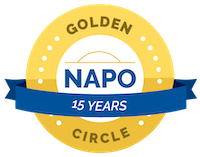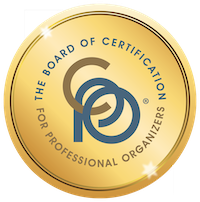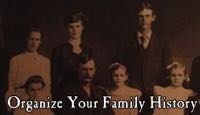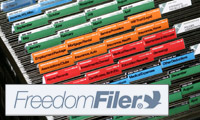Worth repeating: Regifting
I know from working with clients that people have a very difficult time parting with items that were a gift.
When this comes up with clients, I always urge them to ask themselves whether the gift giver would want them to keep an item that they don’t use or love. (Usually the answer is no.) Then I encourage them to give the item to someone else. That someone else could be a stranger (via a charity) or someone they know.
Recently, I met my mother’s first cousin, Penny, for the first time. (We actually met once as kids, but that’s a dim memory.) I was traveling to western Missouri, so I contacted Penny, with whom I’d become reacquainted via email thanks to my genealogy blog. We arranged to spend the day together. (You can read about that fun family reunion on my genealogy blog, Organize Your Family History.)
As we were making the arrangements, Penny offered to regift something to me. She offered me an oil painting that was painted by my grandmother (Penny’s aunt).
To me, this is a perfect example of the power of regifting. Penny is moving and is starting the process of editing her belongings. My parents have my grandmother’s paintings and I imagine I’ll inherit at least one, but this is the first time I’ve been offered one.
Here’s the painting:

"Serenity is the Mood," by Sue Brown
The painting is not exactly my aesthetic. But it was painted my beloved grandmother, whose late-in-life love of painting was a big part of my childhood. I promptly hung it on the wall of one of my home offices. And I cherish it.
If you have items that you don’t cherish or use, but you’re hesitating to let them go because they originally came to you as a gift, please think about happy someone else might be to own that item.
I hereby give you permission to regift!
Getting back to basics with task management
Six months ago, I had a great task management system going. I was using Springpad’s Ninja Task Manager notebook to create a running list of tasks and, from that list, selecting three to five priority tasks per day.
Before that, I’d been a paper-and-pen task manager, through and through. I’d always felt that I needed the tactile experience of writing and crossing off tasks. I created a form that allowed me to select my daily tasks and also reminded me of the routine tasks I wanted to accomplish every day. (And I printed the form and had it glued into pads, which was kind of awesome.)
But Springpad was my transition to electronic task management. It really worked for me. I loved that I could have my task list available to be on my computer, tablet and phone, synched seamlessly. I was happy .
Alas, Springpad went belly up in June. That was a really sad day. It got me hooked on electronic task management and I needed to find another solution. All the data I’d saved in Springpad was migrated to Evernote. So now I’m using Evernote for some project management and for keeping track of certain things. But I don’t like it much for task management.
The solution that I’ve come up with that’s working pretty well for me is TeuxDeux. I like that I have the cross-platform synching. And I like that it looks rather like a paper planner—an attractive user interface is really important to me. I did the 30-day free trial and then happily forked over $24 for a year’s use. (I could have opted to pay $3 monthly.)
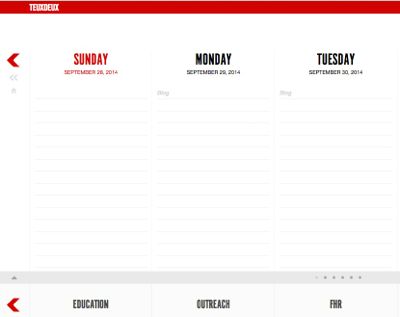
TeuxDeux allows me to keep track of tasks in two ways. One is by project category. The other is by day. It reminds me of the top and middle sections of the paper Planner Pad I used years ago (it just lacks the calendar). One of the big differences between TeuxDeux and Planner Pad: With TeuxDeux, when I don’t do a task that’s scheduled for a particular day, that task is transferred to the next day.
For me, the way to TeuxDeux effectively is to have a master list divided into categories and look it over weekly or daily and assign certain tasks to the days of the week (like I did with Planner Pad). And that works well. When I do it.
In recent weeks, things have gotten a little out of control and I have not been using TeuxDeux effectively. Instead, I’ve scrawled a task list on paper when I felt the need for one. These lists have not been carefully considered, nor have they suitably short. Nor have they been successful.
So I’m turning back to TeuxDeux with a fresh eye. I’ve moved everything off the daily list and into its proper categories. This week, I’ve been surveying the items on today’s list that were holdovers from the day before and deciding whether I can actually get them done today. Then I’ve been adding items from the categories list that can/need to be done today.
The trick for me is not to overload my daily list. I find that if I have only three to four main things on my daily list (the important things), they’re more likely to get done than if they’re surrounded by a bunch of other tasks.
The other trick for me is to add new tasks as they come up to the appropriate category, rather than the day. (That’s where the system derailed for me before.) This will allow me to be selective about what I plan to accomplish in a given day.
I think TeuxDeux has the power to be a really useful tool for me. This week, I’ve made a real effort to get back to basics (for me, that means regularly going over a master list and selecting just a few tasks per day to focus on). So far, so good.
Building in re-entry time after a trip
I was out of town for five days in mid-September. I’ve been back a week and I still don’t have my mojo back.
Travel can wreak havoc on habits and routines. I was a step ahead of the game in that at least I have routines to come back to. But on this trip, I did not build in time to get back into the swing of things. I led an organizing team the morning after I returned (about 12 hours after I got back to St. Louis). The day after that was my birthday and I was determined not to spend my special day working. So I lost that day for catch up.
I actually had a day and a half at my desk last week, which, these days, is quite a bit. Yet, the lowest my email inbox has been is 15. (I strive for inbox zero every weekday.) My desktop houses a perpetual pile. And I’ve been doing a lousy track of planning my tasks for the day. In short, the three components of my evening routine, the ones that keep me on my game, have fallen by the wayside. And, as you may have noticed, I didn’t manage to blog last week!
On Sunday, I had some time to catch up on everything and I hope to be able to get back to my evening weekday routine and it keep it together this week.
I think the way around this in the future is to plan re-entry time. As an entrepreneur, I’m in charge of my schedule. I really like to accommodate clients’ needs, but I also have to bear in mind my need to spend time working on business and staying on top of things.
I’m going to have the chance to practice this in October when I have a whole lot of travel, all of it enjoyable, planned. I vow right now to build in time for re-entry so that I am not too stressed between trips.
Confessions of a conference junkie
Later in the week, I’ll be traveling to Nashville, Tennessee, to attend the annual conference of the Institute for Challenging Disorganization. This is one of two organizing conferences I attend in a typical year. This year, I also attended two genealogy conferences.
I love conferences. I started going to them 25 years ago when I worked in PR for the Missouri Botanical Garden and had the privilege of attending the Garden Writers Association annual conference for six years. In my next career, I met every year with fellow dog writers and fellow cat writers (and I continued to go to garden writers’ conferences).
But it was when I became an organizer in 2005 that I hit the conference motherlode. Most years I attend the annual conferences of both the National Association of Professional Organizers and the ICD. In addition, I’ve had the privilege of attending the conferences of the Australasian Association of Professional Organisers in Brisbane, Australia (I spoke there in 2009), and Professional Organizers in Canada, in Toronto.
Why do I go to the considerable expense and time of attending these conferences year after year? There are so many reasons. Here are a few:
- The education. I learn so much during the conference sessions.
- The CEUs. To maintain my status as a Certified Professional Organizer®, I am required to earn an average of 15 hours of continuing education a year. The conferences help me get those Continuing Education Units.
- The inspiration. I leave a conference all jazzed up about my business. The sessions, along with conversations with colleagues, inspire me to explore new services, to make changes in my business, or simply to focus on the aspects of my business that I love most.
- The networking. By meeting organizers all the country (and the world), I expand my knowledge base. I have people I can call on to help me puzzle out virtually every challenge! I also have people I can refer clients to all over the country.
- The camaraderie. As you might have imagined, I’ve made some really great friends over the years at these conferences. Attending every year is a bit like going to summer camp, I imagine. (I never went to summer camp.)
- The fun. The conferences are held in fun cities (hello, Music City!) and there’s never a shortage of fun stuff to do.
If you’re a professional organizer and you haven’t attended an organizers’ conference yet, please consider putting it in your budget for 2015! If you’re a new or aspiring organizer, I heartily recommend attending a conference early on. I attended the NAPO conference at the first opportunity, before I’d had more than a handful of clients, and it was outrageously beneficial, even if I had to finance it with a credit card.
I’m an extrovert who loves meeting new people. But even introverts can thrive at conferences, with the right amount of alone time scheduled in. Organizers tend to be really nice, friendly people.
If reading this post inspires you to attend a NAPO or ICD conference, please introduce yourself to me at the conference and let me know. I’ll buy you a drink!
Hands Free Tote giveaway winner!
A week ago, I reviewed the Hands Free Tote from United Solutions and offered one up for a giveaway.
I used the Random Number Generator to determine that Amy is the winner! United Solutions will be sending her her own Hands Free Tote. In Amy’s comment, she said that she would use the tote for two things:
(1) Road trips with kid stuff (fewer trips to/from the car), and (2) Running around collecting and hauling stuff upstairs or downstairs during cleanup sessions. (If the basket is strapped to me, I’m more likely to actually put everything away and make sure it’s empty before I set it down!)
It sounds to me like this tote will be put to good use!
There were some other great uses for the mentioned in the entries, including:
- Crafting materials
- Dog supplies
- Baby stuff
- Fabric and sewing supplies
Those are all great ideas for this terrific tote. You can purchase one from Amazon for $19.99 if these ideas have inspired you!
The rewards of a closet purge
My friend and fab professional organizer, Geralin Thomas, came for a visit a couple of weeks ago. One of the services Geralin offers her clients is wardrobe organization, which includes closet organizing and wardrobe selection. She helped me six years ago (time flies!) and I leaped at the chance to have her help me with my wardrobe again.
We were on a tight schedule and we started with a couple of hours in my closet. We went through the whole closet and she weighed in on whether or not I should keep each item. The idea was that donating the clothing that I don’t wear or doesn’t suit me allows me to see what I do have to use as a base for creating wardrobe capsules.
For each item, we considered the following:
- Whether I like it
- Whether I wear it
- If it’s flattering on me (Geralin’s very good at gently telling me when an item is unflattering)
- If it’s still in style
- If it’s age appropriate
- If I have multiples of the same type of item, and if so, which to keep
In going through this process, I was amazed at how few items made the cut. We filled two large trash bags with donations. (I took them to the Scholarshop which will provide me with a valuated receipt for tax purposes.)
Then we went shopping. Unfortunately, we hit bad traffic and were left with only about an hour to shop. I purchased five terrific pieces of clothing under Geralin’s guidance and that was that.
In the section of my closet where I store tops, I put away the new clothes and moved all the empty hangers to one side. Here’s a photo.
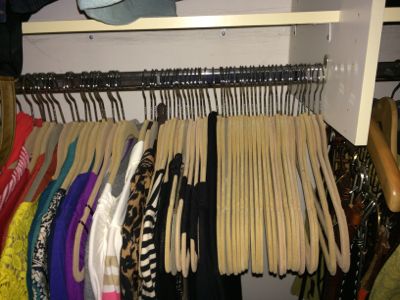
I have to admit that I freaked out a little that my closet was so empty. There are definitely some wardrobe gaps that need to be filled! (I was left with only one pair of dress pants, for example.) But Geralin guided me on the basics I need to buy to build a great capsule wardrobe.
After I moved the empty hangers to a spare closet and got used to the idea that the stuff was gone, I began to realize the rewards:
- I can see everything I own much more easily
- The closet contains only clothes I actually like and wear
- Clothes hang more freely and therefore stay more wrinkle-free
- It’s much easier to make choices because there are fewer options (which makes decisions so much easier for me)
- I can put clothes away with virtually no effort
- There are no clothes in the closet mocking me for my bad judgment or making me feel guilty for not wearing them
- I know what clothes I need and I can shop mindfully
In looking around the web on blogs about wardrobe capsules and minimalist dressing, I came upon the Un-Fancy blog, which I’m enjoying. If you’re intrigued at the idea of dressing well with fewer clothes, you might want to check it out.
If your closet is overstuffed, consider letting go of those items that don’t make you feel fabulous. It can be a little scary, but it can also be really rewarding. If you want to take the plunge, Geralin offers personal style coaching over the phone!
Hands Free Tote: A review + giveaway
From time to time I receive emails from manufacturers of products that might interest my readers. They typically offer to send me a product sample, hoping I’ll review it. I don’t promise a review, but I often say yes and offer to give feedback on the product, which is mine to keep. When I really like a product, I’ll review it and do a giveaway.
Today, I want to write about one of those products! It’s the Hands Free™ Tote, from United Solutions. When I unpacked the tote, which resembles a large, rectangular, high-sided laundry basket with a strap, I had a hard time imagining I would find it useful. I was wrong.
Here’s a photo of the tote (courtesy of United Solutions):
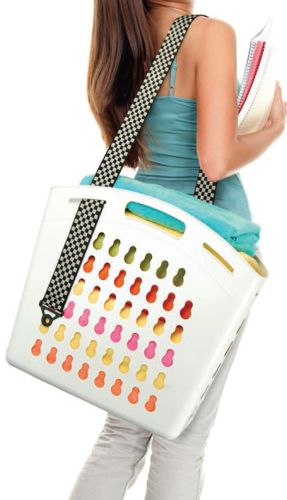
It’s sturdy, but light weight. (It supposed to hold up to 25 pounds.) The strap is long enough for me to comfortably wear it across my chest, so what I’m carrying can rest behind my shoulder, leaving my hands completely free to carry other stuff. (It’s kind of like having a third hand!) It looks a little awkward, but I find it’s really functional.
Here are the ways I use it so far:
- I live in an old house in an urban neighborhood and our recycling dumpster is about four or five houses down the alley. The Hands Free Tote allows me to carry more to the recycling bin at a time, thereby reducing the number of trips I take.
- My small garage is not attached to my house. I walk across the back yard to get to it. The Hands Free Tote makes schlepping organizing supplies I use for client appointment to and from the house much easier. (There’s not room to store that stuff in the garage.)
Here are some ways I could imagine using it in the future (or others using it):
- The Hands Free Tote would make a great container for the Relocate to Another Room category during a decluttering session. Once you’ve finished your decluttering session, just carry around the tote to the various rooms of your house and put those items away.
- Guests coming? Use the Hands Free Tote for quick clean up. Put it over your shoulder and deposit items in it that need to be taken to other rooms. In a pinch, you could temporarily store those items in the tote until you have time to put them away. (I really don’t advocate the “stash and dash” approach to clutter control, though.)
- if you have a baby or a toddler, the Hands Free Tote would presumably allow you to easily carry relatively large quantities of stuff from one room to another with a baby on your hip. (I know from clients that that can be a challenge.)
United Solutions partnered with popular gardening personality P. Allen Smith to promote the Hands Free Tote. Here’s a video from his YouTube channel that shows the tote in action.
Here’s the fun part—the giveaway! United Solutions has offered to send one of my readers their own Hands Free Tote. To enter, post a comment below about how you would use the Hands Free Tote. After you’ve entered with a comment, you may get additional entries by tweeting about the giveaway (be sure and use @janinea in the tweet, so that I see it) and/or writing on the wall or commenting at the Peace of Mind Organizing Facebook page. The contest ends at 11 pm, central time, on Thursday, September 11. I’ll announce the winner on Friday, September 12.
The giveaway is now over. Congratulations to Amy for winning!
Search
Recent Posts
- Budgeting and decluttering: It's all about priorities
- Today's truth bomb
- Worth repeating: Labels in the refrigerator
- The meat of my Bullet Journal
- Worth repeating (again): Getting past "I might need it some day"
- Furthering your goals one tiny step at a time
- Repeating spreads in my Bullet Journal
Tags
Links
- Organize Your Family History
- Getting to Good Enough podcast
- Peace of Mind Spending
- National Association of Productivity and Organizing Professionals
- Ravelry
- Are you interested in becoming a professional organizer?
- Shannon Wilkinson, life coach
- Institute for Challenging Disorganization
- NAPO St. Louis

